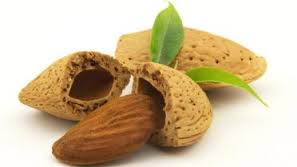Cyanide or hydrocyanic acid (HCN, or hydrogen cyanide) is a powerful poison that acts on all animals. Plants use it to protect themselves against predation. One thinks. Some arthropod butterflies and mites make it harmless by a gene they have 'stolen' from a bacteria. They feed on the highly toxic plants, and use the toxins for their own defense against predators. (Professor Luc Tirry, Department of Crop Protection / Ghent University)
Sources mention about 2,000 species, up to 10% of the plants contain the hydrogen cyanide compounds.
 These include, apricot kernels, almond kernels (especially in the bitter, much less in sweet), apple seeds, grape seeds, cherry pits and peach kernels, beech nuts, walnuts, warmed spinach, fresh bamboo shoots, cassava, sago (lima) beans, linseed, peanuts, coffee beans, rowan, yew, cherry, cherry laurel, rubber tree, eucalyptus leaf, clover, purple moor grass and some mushrooms.
These include, apricot kernels, almond kernels (especially in the bitter, much less in sweet), apple seeds, grape seeds, cherry pits and peach kernels, beech nuts, walnuts, warmed spinach, fresh bamboo shoots, cassava, sago (lima) beans, linseed, peanuts, coffee beans, rowan, yew, cherry, cherry laurel, rubber tree, eucalyptus leaf, clover, purple moor grass and some mushrooms.
Saving an extended time may cause the hydrocyanic acid content decreases, e.g. in walnut, beech nuts and peanuts.
Automobile exhaust and cigarette smoke also contain hydrocyanic acid.
Our body is able to take a daily limited amount of cyanide which the liver converts to less harmful thiocyanate.
(Tomatoes, potatoes and rhubarb are poisonous, but not harmful. This is increasingly dependent on the use, operation and especially the dose.)
Hydrocyanic acid is in sugar compounds or glycosides. Thus, plant cells do not contain any pure prussic acid, but compounds containing it, together with an enzyme, that the prussic acid can detach from the glycoside. If the cells are damaged, the two come into contact with each other, and create free hydrogen cyanide.
Amygdalin is a natural substance which is prepared from bitter almonds. Laetrile is chemically treated amygdalin. It is also called vitamin B17. However, it is not a vitamin (but a meta vitamin).
Difference almond - apricot kernels
Almonds: limit eating to 10-15 per day, especially if they are bitter.
The almond tree Prunus dulcis is a close relative of the cherry, peach and apricot tree.
The seed resembles the raw kernel of peach (with a thin, unappetizing peach around) and is very hard. If you use a nutcracker, it will often not break the scale, but the nutcracker. I use XL heavy pliers.
Bitter almonds contain approximately 2-3 % of the toxic prussic acid glycoside: amygdalin. In sweet almonds is virtually no amygdalin. From amygdalin about 4-9 mg hydrogen cyanide can be released from one bitter almond. Almonds are even illegal in some countries!
Substitutes
From apricot- or peach kernels , a marzipan substitute is made: persipan (40 % kernel, 60 % sugar).
Banquet (bakers) food contains ground apricot kernels, beans, sugar and vegetable fat.
In apricot (Prunus armeniaca), the smoother and sleeker pit looks more like that of a plum.
Apricot kernels contain 217 mg cyanide per 100 grams. A lethal dose of hydrogen cyanide for an adult is about 3.7 mg per kg of body weight. Alternative medicine and quacks often use it as a miracle cure for cancer.
Cassava or manioc (Manihot esculenta) is a cyanide-containing edible (original Brazilian) tubers of a woody, perennial shrub. Prussic acid glycoside can be rendered harmless by heating, storage or rinsing with water.
To some sweet smaller varieties cooking is enough to eliminate the poison. Others are peeled (the peel contains a lot of poison), cut in pieces or grated, mashed and possibly 18 - 24h soaked in water and squeezed. This halves the cyanide content. (The stamp water you pour away, best not always in the same spot.)
(In Africa, they are sometimes three days fermented, then dried or cooked.)
Also, cassava flour is washed, and then dried to get the HCN (hydrogen cyanide) removed. The content ranges from 20 mg HCN / kg of fresh 'sweet' tubers up to 1000 mg / kilo 'bitter cassava’.
Some things, also from our daily life can be deadly. That depends mainly on the amount (and of course, condition, preparation ed.):
cyanide of two cherry stones
6 liters of water
too loud music (+185 dB)
a height of +7,300 meters (lack of oxygen)
200 milligrams of mercury
Caffeine from 70 cups of coffee
13 glasses of alcohol
6 minutes without oxygen
chocolate (theobromine) is lethal to a dog. 58 packs at the same time also for man
4.5 kg rhubarb leaves
48 teaspoons salt
0.5 kilo completely green potatoes
undercooling
5 to 10 grams ergot
fungi, bacteria, parasites,
(and several mushrooms, but also berries and plants. Know what you're eating. And how many. And how (raw, cooked ..)
